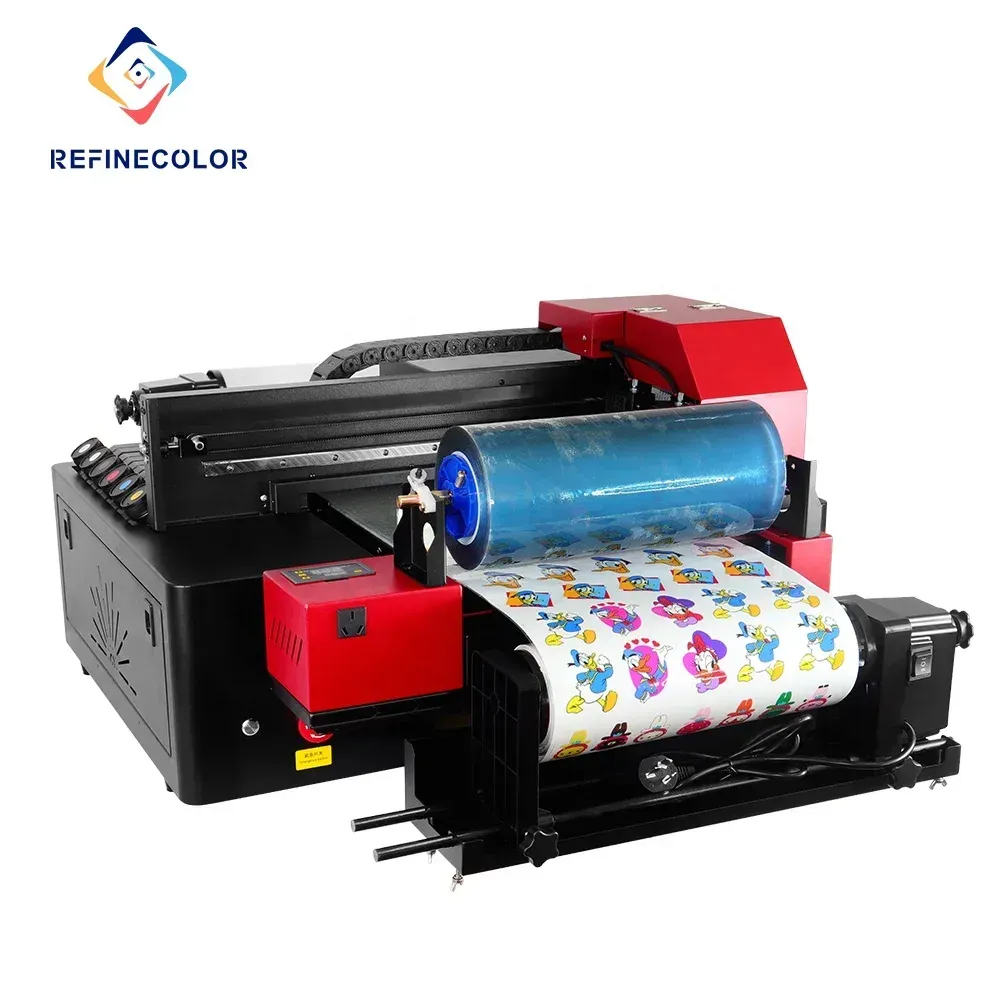In the ever-evolving landscape of printing technology, **UV Direct to Film (DTF)** has captured the attention of both professionals and hobbyists alike, thanks to its unique capabilities and impressive results. This innovative method leverages ultraviolet light to cure specially formulated inks onto various surfaces, significantly enhancing the quality of printed materials. With a focus on vibrant colors and durability, UV DTF is rapidly gaining traction as an alternative to traditional digital printing methods. Eco-friendly printing practices further bolster its appeal, as many UV inks contain low volatile organic compounds (VOCs), making it a sustainable choice for modern consumers. Understanding the benefits of UV DTF not only broadens your printing horizon but also positions you on the forefront of the latest trends in UV printing technology.
Introducing **Ultraviolet Direct to Film**, often abbreviated as UV DTF, opens up a world of possibilities in the realm of contemporary printing methods. This advanced printing technique allows for the application of high-quality inks onto various substrates, ultimately revolutionizing how brands and artists communicate their ideas visually. In contrast to conventional approaches that rely on heat or staggering drying times, UV DTF provides an immediate and efficient solution, perfect for those looking to streamline their production processes. Moreover, the versatility of UV ink applications means that whether you are printing on fabrics, metals, or plastics, the results are consistently vibrant and long-lasting. The growing interest in eco-friendly printing further emphasizes the importance of UV DTF, which combines innovation with sustainability, compelling businesses to embrace this cutting-edge solution.
Understanding UV DTF Technology
UV Direct to Film (DTF) technology is revolutionizing the printing landscape by providing an innovative solution for producing high-quality prints. This unique process relies on ultraviolet light to cure special inks that are directly applied to a film substrate. Unlike traditional methods where drying can take time and lead to potential smudging or misalignment, UV DTF dries instantly, ensuring that the final product retains vibrancy and sharpness. For beginners looking to delve into this technology, it is essential to grasp how the UV curing process works and its impact on the finished print quality.
Furthermore, the robustness of UV DTF compared to standard digital printing methods cannot be overstated. Traditional inks may fade or lose color over time, especially when exposed to sunlight or water. UV inks, on the other hand, strike a balance between flexibility and durability; they resist scratching and are less susceptible to environmental conditions. This makes UV DTF an appealing choice for various industries, from fashion to promotional products.
The Environmental Benefits of UV DTF Printing
As more businesses and consumers become environmentally conscious, the demand for sustainable printing solutions has surged. UV DTF emerges as a frontrunner in this regard due to its eco-friendly formulation and processes. Many UV inks are formulated with low volatile organic compounds (VOCs), significantly reducing harmful emissions when compared to traditional printing inks that can contain high levels of solvents. Choosing UV DTF not only helps in producing high-quality prints but also aligns with the growing trend of sustainability.
Additionally, the efficiency of the UV curing process minimizes energy consumption in production. Since there is no need for heat drying, the overall energy footprint of a UV DTF printer can be lower than that of standard printers. As industries shift towards adopting greener practices, integrating UV DTF into print operations caters to both customer demands for better environmental practices and the necessity for high-quality output.
Exploring the Versatility of UV DTF Applications
One of the most compelling aspects of UV DTF is its remarkable versatility across a broad spectrum of materials. This printing technology is not restricted to traditional substrates such as paper or fabric; it can effectively print on metals, plastics, and even glass. This opens up a wealth of creative opportunities for designers and businesses looking to showcase their work in new, dynamic formats. Whether you’re creating signage, custom merchandise, or unique fashion items, UV DTF can accommodate an array of projects.
Moreover, the ability to print on unconventional surfaces means that businesses can expand their product offerings and explore new markets. As industries evolve, the demand for custom branding on diverse materials will only continue to grow. Embracing UV DTF can position companies well within competitive markets, allowing them to meet ever-changing consumer preferences head-on while delivering high-quality, lasting products.
Innovations in UV DTF Technology
Recent innovations in UV DTF printers have enhanced their functionalities and user-friendliness, making it easier for beginners to engage with this technology. Manufacturers have prioritized intuitive designs, leading to improved interfaces that simplify the printing process. Features such as automatic color management and real-time feedback on printing conditions allow even novice users to produce professional-grade outputs without prior experience.
Additionally, advancements in UV ink formulations mean that users benefit from even more vivid colors and improved adhesion to a wider variety of substrates. These innovations not only increase efficiency but also broaden the scope of applications that UV DTF can cater to, making it suitable for both small-scale creative projects and large-scale commercial needs.
The Growing Market for UV DTF Printing
The UV DTF printing market is witnessing significant growth as businesses recognize the potential of this technology. With increasing adoption in diverse sectors, including fashion, advertising, and decor, the demand for high-quality, versatile printing solutions is on the rise. Market research suggests a robust trajectory for DTF technologies, driven by the desire for customization and unique branding solutions.
This growing market encourages continuous research and development, fostering innovations that enhance quality and expand capabilities. For entrepreneurs and print professionals, this environment presents a ripe opportunity to invest in UV DTF technology and leverage the expanding customer base that seeks out quality, customization, and eco-friendliness in their printed products.
Beginning Your Journey with UV DTF Printing
Starting with UV DTF printing requires careful consideration and planning, especially regarding equipment and substrate choices. It is vital for newcomers to familiarize themselves with the different types of printers available, as various models can offer unique features tailored to specific printing needs. Investing in a reliable printer that matches your business requirements will lay the foundation for success in your printing endeavors.
Additionally, exploring various substrates is essential for achieving optimal results with UV inks. Experimentation is encouraged, as users will discover the compatibility and effects different materials have on print quality. Engaging with online communities and utilizing available resources can provide invaluable insights and support on this exciting journey into the world of UV DTF printing.
Frequently Asked Questions
What is UV DTF and how does it utilize UV printing technology?
UV DTF, or Ultraviolet Direct to Film, is an innovative printing method that employs UV printing technology to cure specialized inks on a coated film instantly. This process allows for vibrant colors and precise details, making it suitable for a wide range of applications on various surfaces.
What are the benefits of using UV DTF compared to traditional printing methods?
The benefits of UV DTF include greater durability, as its UV-cured inks are resistant to scratching, fading, and water exposure. Additionally, UV DTF is considered an eco-friendly printing method, as it uses low VOC inks, making it a sustainable alternative to traditional digital printing methods.
What types of surfaces can UV DTF printing be applied to?
UV DTF printing is highly versatile and can be applied to various surfaces, including textiles, plastic, metal, glass, and more. This allows creators to explore a broad range of UV ink applications and expand their product offerings.
How does UV DTF compare to other digital printing methods in terms of quality?
UV DTF printing offers superior quality compared to many other digital printing methods, providing high-resolution imagery with sharp pigmentation. This capability makes it especially popular among graphic designers and businesses seeking detailed and intricate designs.
Is UV DTF an eco-friendly printing option?
Yes, UV DTF is considered an eco-friendly printing option. It utilizes UV inks that generally contain low volatile organic compounds (VOCs), minimizing environmental impact during production compared to many traditional printing techniques.
What should beginners know before starting with UV DTF printing?
Beginners should familiarize themselves with available UV DTF printer models, substrate choices suitable for UV inks, and maintenance requirements to ensure efficient operation. Utilizing online resources and joining communities can also provide support and valuable insights for newcomers.
| Key Point | Description | Applications |
|---|---|---|
| What is UV DTF? | UV DTF stands for Ultraviolet Direct to Film. It cures inks using UV light, resulting in vibrant colors and detail. | Printing on textiles, metals, plastics, and glass. |
| Advantages of UV DTF | Includes durability, eco-friendliness, and versatility. | Utilized in fashion, promotional products, and graphic design. |
| Current Trends and Developments | Technological advancements and a growing market are enhancing UV DTF capabilities. | Increased precision, efficiency, and innovation in printing solutions. |
| Getting Started | Familiarize with equipment, choose suitable substrates, and maintain printers. | Engagement with online resources and communities. |
Summary
UV DTF is an innovative printing technology that offers a range of benefits for users looking to enhance their printing capabilities. This advanced method is gaining traction due to its ability to produce durable, high-quality products across various applications, from fashion to promotional items. As industries increasingly adopt UV DTF, the opportunities for creativity and productivity expand, inviting beginners to explore its vast potential. By familiarizing oneself with essential tools, substrates, and community resources, one can tap into the exciting world of UV DTF printing and harness its many advantages.



